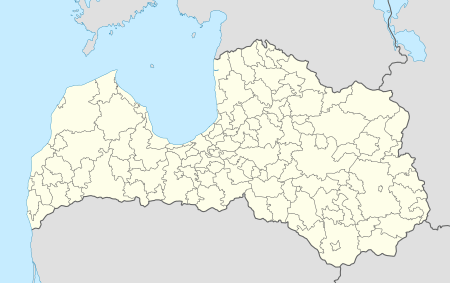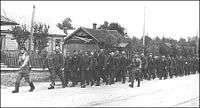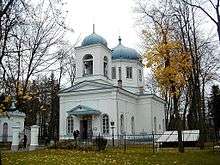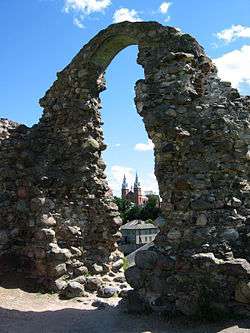Rēzekne
| Rēzekne | |||
|---|---|---|---|
| City | |||
|
The Rēzekne castle mound with Livonian Order castle ruins | |||
| |||
 Rēzekne Location in Latvia | |||
| Coordinates: 56°30′23″N 27°19′50″E / 56.50639°N 27.33056°E | |||
| Country |
| ||
| First mentioned | 1285 | ||
| Town rights | 1773 | ||
| Government | |||
| • Mayor | Aleksandrs Bartaševičs | ||
| Area | |||
| • Total | 17.48 km2 (6.75 sq mi) | ||
| • Land | 16.74 km2 (6.46 sq mi) | ||
| • Water | 0.74 km2 (0.29 sq mi) | ||
| Elevation | 158.2 m (519.0 ft) | ||
| Population (2011) | |||
| • Total | 32,328 | ||
| • Density | 2,079/km2 (5,380/sq mi) | ||
| Time zone | EET (UTC+2) | ||
| • Summer (DST) | EEST (UTC+3) | ||
| Postal codes |
LV-4601 LV-4604 LV-4605 LV-4606 | ||
| Calling code | +371 646 | ||
| Number of city council members | 13 | ||
| Website |
www | ||
Rēzekne (Latvian: Rēzekne, Latvian: Rêzekne pronounced [ˈrɛːzekne]; Latgalian Rēzne pronounced [rʲæːzʲnʲæ] or Rēzekne pronounced [ˈrʲæːzʲækʲnʲæ]; German: Rositten; Polish: Rzeżyca Russian: Резекне or Режица Rezhitsa) is a city in the Rēzekne River valley in the Latgalia region of eastern Latvia. It is called Latgales sirds (Latgalian Latgolys sirds) meaning The Heart of Latgalia. Built on seven hills, Rēzekne is situated 242 kilometres (150 miles) east of Riga, and 63 kilometres (39 miles) west of the Latvian-Russian border, at the intersection of the Moscow – Ventspils and Warsaw – Saint Petersburg Railways. It has a population of 35,883 (2008), making it the 7th largest city in Latvia.
History

A Latgalian hill fort[1] is known to have existed at Rēzekne from the 9th to the 13th centuries, until its destruction at the hands of German crusaders of the Livonian Order. In 1285, the knights built a stone fortress on the site, which is today known as Rēzekne castle ruins, to serve as a border post on their eastern frontier.
The name Rēzekne was first documented in 1285. Throughout its early history, Rēzekne was attacked many times by Russian and Lithuanian forces. The town became part of the Polish–Lithuanian Commonwealth after the Peace of Jam Zapolski in 1582 during the Livonian War.[1] Rēzekne received Magdeburg rights from Poland in the 17th century, but fell to the Russian Empire during the Partitions of Poland. In 1773, Rēzekne received city rights. Known as "Rezhitsa" during Russian rule, it was an uyezd center first in Pskov Governorate between 1772 and 1776, then Polotsk between 1776 and 1796, Belarus between 1796 and 1802 and finally in Vitebsk Governorate between 1802 and 1917.
During the 19th century, the construction of the Moscow-Ventspils and Saint Petersburg-Warsaw railways transformed Rēzekne from a sleepy country town into an important city with two stations.
In the spring of 1917, the first Latgalian congress was held in Rēzekne, in which Latgale was declared to unite with the other Latvian regions. Following Latvia's declaration of independence in 1918, the Latvian War of Independence and the driving out of both the German and Red armies from Latvia, the city became a cultural centre for all of Latgale.

Rēzekne was heavily damaged by both Nazi and Soviet armies during World War II. It was captured by troops of the German Army Group North on 4 July 1941 and placed under the administration of the newly created Reichskommissariat Ostland on 25 July 1941. Rēzekne was recaptured by troops of the Soviet 2nd Belorussian Front on 27 July 1944. Due to the heavy air-bombing by Soviet forces in 1944, ⅔ of its buildings were destroyed. Out of a pre-war population of 13,300, only 5,000 people remained in the city at the end of the war.
Rēzekne was rebuilt after the war with an emphasis on industrial development. Rēzekne had the 5th highest industrial output in the Latvian SSR, including a dairy processor (Rēzeknes Piena konservu kombināts), a lumber mill, and an electric-instrument factory (Rebir). During this time, many Russians moved to the city, making up a large part of the population (48.5% in 2007).
Demographics
Based on the data provided by Latvijas Statistika, the population of Rēzekne was 10,795 in the year 1897 decreasing to 9,997 in 1920, while increasing again to 12,620 and then to 13,139 in years 1925 and 1935, respectively.[2]
As a result of the Pale of Settlement many Jews settled in Latgalia and were confined to the cities. In the 19th century, the population of Rēzekne was around 60% Jewish, while Russians formed the largest minority (about 24% in 1897[3]). The remainder of the population included Poles, Germans, and a small number of native Latgalians. With the economic development following the arrival of the railroad, the population grew steadily, reaching 23,000 by the eve of World War I.
After Latvia's independence in 1918, the population of ethnic Latvians in the city grew substantially, but Jews still made up slightly over a quarter of the population (25.4% in 1935.) In 1939, the population was 13,000. During World War II, the Jewish population was annihilated, and most other residents were either deported to Gulag camps in Siberia, or fled westwards. As a result, the post-war population was only 5,000.
As part of the Soviet Union's policy of Russification, many Russians and Belarusians moved to the city. By 1989, Russians accounted for the majority of the population, at 53%. After Latvia's independence in 1991, many repatriated to Russia.
In 1991, the population of Rēzekne was 43,156. Since then, the population has decreased to 32,295 (2011), caused by a low birth rate, an old population (the average age in Rēzekne is 40.3 years) (see also ageing of Europe), and a high rate of emigration abroad and to larger cities such as Riga.
Religion

Due to Rēzekne's multi-ethnic character throughout the centuries, many religious communities have settled in the city. Ethnic differences were often distinguished on religious lines; the Germans brought Christianity to Latvia in the 13th century, as well as Lutheranism during the Reformation Period. The Polish influence over Latgalia in the 17th and 18th centuries strengthened Catholicism among the native Latgalians. Incoming populations of Russian Old Believers introduced Russian Orthodoxy, and up to the 1940s, Rēzekne had a very large Jewish population, and therefore, many synagogues.
Heart of Jesus Cathedral

The Catholic Cathedral "Vissvētā Jēzus Sirds" (Sacred Heart of Jesus), (built 1893-1914) dominates Rēzekne's skyline looking from the castle hill.
The Cathedral was consecrated in 1901. It was built on the site of a previous wooden church which had been constructed from the funds allotted by Kraków military leader Belinskis. In 1887 the church was destroyed in a thunderstorm-caused fire.
The cathedral has curved wooden altars decorated by the sculptures of Jesus Christ, Virgin Mary, St.Teresa, and others. The cathedral is famous for its depictions in stained glass of the first Livonian bishops, St. Maynard and St. Albert. Since 1995 it has been the centre of the Rezekne-Aglona diocese with the seat of the bishop.
The church has an active choir whose members have studied music. A majority of the members work as musicians and enjoy their Sunday singing in the church.
Our Lady of Sorrows Roman Catholic Church

The other Catholic church, "Sāpju Dievmāte" (Our Lady of Sorrows) is much newer, built from 1935-1939.
Construction began in 1936. The 27 metres (89 feet) tall building was built in neo-romantic style. The church was consecrated on 6 December 1937, but the construction was finished only in 1939. Next to the church is a sculpture of Our Lady of Fátima.
Like many 1930s buildings in the city such as the Nation Palace of Latvian Society (the House of Culture nowadays), the Secondary School no.3 elementary school, and the Red Cross Hospital (nowadays a students hostel) it was designed by the architect Pavlov.
Orthodox Church of the Birth of Holy Jesus' Mother

Construction of the church dates back to 1840, though it wasn't consecrated until 1846. In 1854 it was closed for reconstruction. After a two-year reconstruction period the church obtained its definitive look.
Tile stoves, tiled floors, three-storey iconostasis and a granite stoop decorated the church. A small stone chapel in memory of Alexander II's rescue from death is situated on the left side of the church entrance. On the right there is a glass burial vault where the founder of the church, the owner of the Adamova manor general Karaulov and his wife Helen were buried.
Evangelical Lutheran Holy Trinity Church

The red brick church from was built in the 1930s. The church was designed by the architect J.Cirulis in Neo-Gothic style. The church was consecrated in 1938. In the summer of 1949 the Soviet authority deprived the parishioners of their church, removed its crosses and dismantled the belfry. For many years there was a film rental company.
The parish got back its property at the beginning of the 1990s and the building has undergone major repairs. It is possible to climb the 37 metres (121 feet) bell tower and see Rēzekne from above. Classical music concerts and divine services take place in the church nowadays.
St.Nicholas Old-Believers' Church

The church was built in 1895. In 1906 it was considerably reconstructed, with a belfry with three bells, for which the church is now famous. One of them weighs 4,832 kg (10,653 lb) and is the biggest bell in Latvia. The bell clapper alone is 200 kg (441 lb) heavy.
A museum is now opened in the premises of Rezekne Old-Believers Cemetery Commune which shows the daily routine and lifestyle of Latgalian old-believers. In one of the rooms the collected items reflect church life, another has etnographical items. The museum can be visited on request.
Green Synagogue

Prior to World War II, there were eleven synagogues in Rezekne. The Green Synagogue is the only one to have survived to this day.
The synagogue was built in 1845 and is considered to be one of the oldest wooden buildings in Rēzekne. The synagogue was open until the 1990s, when it was closed for fire safety reasons.
The State Inspection for Heritage Protection of Latvia added it to the list of the most endangered sites in 2004. The Rezekne City Council with the support of Norwegian Financial Institutions started reconstruction of the building. Within the framework of the project it will be possible to create an exhibition devoted to the history of Rezekne's Jews.
Latgales Māra
One of the most famous statues in Latvia, known as "Latgales Māra", is found in Rēzekne. It was designed by Leons Tomašickis and first unveiled on September 8, 1939. The bronze statue commemorates the liberation of Latgale from the Red Army in January 1920.
The central figure, the woman, is popularly associated with "Māra" the ancient Latvian goddess of motherhood, fertility, and earth. The cross in her outstretched arm symbolizes the deep importance of Catholicism to Latgalian culture. The words "Vienoti Latvijai" beneath the statue (meaning "United for Latvia") designates the decision to reunite with the rest of Latvia during the Republic's formation in 1918, even though Latgale had been politically separated from the rest of Latvia for 300 years.
Because the statue symbolized Latvian nationalism, the Soviets toppled it in November 1940 during the Soviet occupation of Latvia. Under German occupation the local residents restored it on August 22, 1943. The reinstated Soviet government pulled it down again in June 1950. After that, the fate of the original statue is unknown.
After Latvia regained its independence in 1991, the statue was reconstructed using old photographs and blueprints, and unveiled on August 13, 1992. Though Soviet rule greatly changed Latgale, Latgales Māra still symbolizes a Catholic Latgale united with Latvia, free of foreign domination.[4]
Castle Ruins
The Castle Ruins, situated on the hill by the river, are the reminders of the ancient fortified residence of ancient Latgalians which existed there from the 9th to 13th centuries. At the end of the 13th century the Livonian Order built a stone castle (Rozitten castle). It was situated in a strategically important place, so the Russians, Lithuanians and Poles were seeking to conquer it. The castle was completely destroyed during the Polish-Swedish war (1656-1660). A model of Rēzekne castle by Edmunds Smans is located near the castle hill.
Latgale Culture and History Museum
The Latgale Culture and History Museum (Latgales Kultūrvēstures muzejs) was opened in 1959. The museum offers exposition of the town history, art exhibitions, and pedagogical activities for children. The exposition of Latgale ceramics is the only permanent exposition in Latvia to reflect Latgalian ceramics in its history from the beginning of pottery in the Neolithic period until the achievements of present-day Latgalian ceramists and modern developments. At the moment the museum stock collection has about 65 thousand items.
Art House
The building which is now the Art House was built in the last quarter of the 19th century for the merchant Vorobjov. It features rich woodcarvings on its façade, decorated in an eclectic style.
It soon became the property of the city, and was used as a teachers' institute, a school, a tuberculosis centre and a military registration office. This frequent change of users almost totally destroyed the original rich interior.
In the middle of the 1990s it was acquired by the Rezekne Art College. Due to the efforts of the students and teachers, the Art House got back its original outlook. It houses the exposition "Latgalian painting" from the reserves of the Latgale Culture History Museum.
Eastern Latvia's Center of Creative Services "Zeimuļs"

The Eastern Latvia's Center of Creative Services "Zeimuļs", also known as "Caran 'd Ache", houses classes of interest and non-formal education for children and youth.
The opening of the center was on September 1, 2012. The architects were Rasa Kalnina and Maris Krumins who used Latvian etnographic motifs in their design. The main construction materials are concrete, glass, metal and wood. It is the largest building with a green roof in the Baltic countries. The towers offer one of the best views in Rezekne, over the Castle Hill and the historical center of the city.
The Embassy of Latgale "GORS"

The Embassy of Latgale GORS is a multifunctional centre where the story of Latgale is told. Its cultural heritage, ancient values and new ideas along with creativity and language can be found here and enjoyed by young and old. It is a home to singers, dancers, with concert halls and art galleries, a cinema and restaurant.
Notable residents
- Eber Landau (1878–1959) physician and professor
- Fridrikh Ermler (1898–1967) Soviet film director
- Aiga Grabuste (1988-) Latvian heptathlete.
- Yury Tynyanov (1894–1943) Soviet/Russian writer and literary critic of Jewish origin.
- Iveta Apkalna (born 1976) world-famous Latvian organist
- Teuvo Tulio (born Theodor Antonius Tugai, 1912–2000) Finnish film director and actor born in Rēzekne.
- Vladislavs Kozlovs (born 30 November 1987), footballer
Twin towns – Sister cities
Rēzekne is twinned with:
-
 Arendal, Norway
Arendal, Norway -
 Częstochowa, Poland
Częstochowa, Poland -
 Dmitrov, Russia
Dmitrov, Russia -
 Lianozovo, Russia
Lianozovo, Russia -
 Suwałki, Poland
Suwałki, Poland -
 Vitebsk, Belarus
Vitebsk, Belarus -
 Lainate, Italy
Lainate, Italy
References
- 1 2 Rēzekne.com. "History." Retrieved October 4, 2006.
- ↑ Rēzekne.com. "."
- ↑ First general census of the Russian Empire. Distribution of the population by native language in the districts of 50 governorates of European Russia (Russian)
- ↑ Rēzekne.com. "For united Latgale - Latgales Māra." Retrieved October 4, 2006.
External links
| Wikimedia Commons has media related to Rēzekne. |
- Official website
- Rēzekne after World War I
- Monument for a liberation of Latgale
- Awarded "EDEN - European Destinations of Excellence" non traditional tourist destination 2008
- The murder of the Jews of Rēzekne during World War II, at Yad Vashem website.
Coordinates: 56°30′46″N 27°20′34″E / 56.512716°N 27.342739°E


